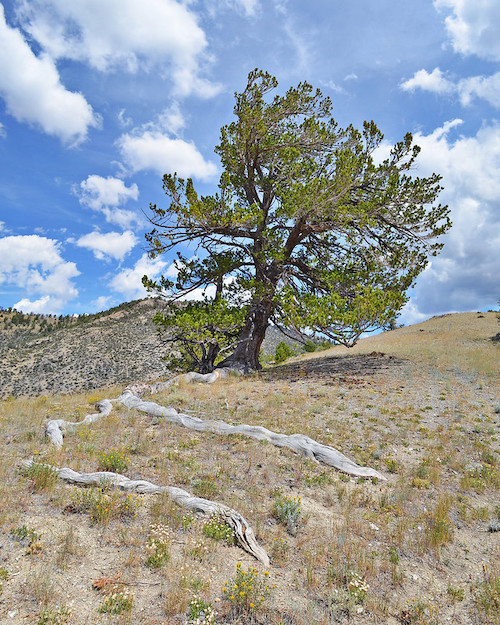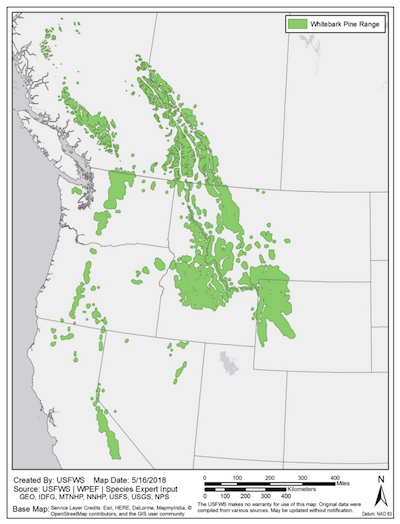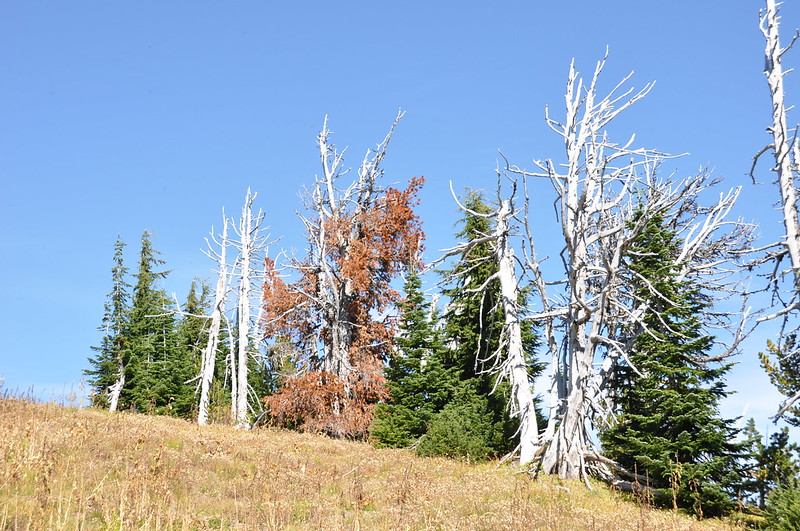
The Whitebark pine (Pinus albicaulis) is a tree found in high elevations. It is a keystone species of subalpine habitat, producing starchy pine nuts that many species rely on.
Conservation status: Threatened
It is a joy to see a mature whitebark pine. Unlike its neighbor the subalpine fir, which looks like a wizards hat in shape, the whitebark pine spreads its arms up, branches akimbo in the cold mountain air. Its broad canopy of needles all come in bunches of five, like its close relative the Western white pine.
The whitebark is adapted to the high mountains, in places above 6,000 feet (~1,800 meters). In this low-calorie landscape, the whitebark is a keystone species. Their starchy pine nuts sustain all sorts of high-elevation animals. Red squirrels create large caches of pine nuts, called middens, that grizzly bears often raid and devour, especially in fall and springtime.
A combination of forces have obliterated whole forests of whitebark pines. In late 2022, the US Fish and Wildlife Service (USFWS) listed the whitebark as threatened under the Endangered Species Act (ESA). This listing marks the first occasion in which a tree regarded as ecologically important in the United States is acknowledged as vulnerable to extinction.
Species Description: Member of the white pine group. Needles in fascicles (bundles) of five with a deciduous sheath. Lodgepole pine (Pinus contorta) has two needles per fascicle Ponderosa pine (Pinus ponderosa) and Jeffrey pine (Pinus jeffreyi) have three needles per fascicle.
Physical Characteristics: Whitish to light gray bark of young trees, older trees are darker. Generally highest-elevation pine tree found in its range, marks tree line. May be dwarfed by wind and exposure, referred to as "creeping pine". Can grow to 29 meters (95 ft) in favorable conditions.

Ecology and Habitat: Trees are slow to mature and can live 1000 years.Produce seed cones after 25-30 years (peak production 60-80 years). Clark's nutcracker (Nucifraga columbiana) is the major seed disperser. Birds cache seeds in soil or gravelly substrate for future food source. Caches not retrieved contribute to forest regeneration. Thus, whitebark pine often grows in clumps of several trees, originating from a seed cache. Other animals also depend upon seeds. Douglas squirrels cache seed in middens. Grizzly bears and American black bears raid middens as an important pre-hibernation food. Squirrels, northern flickers, and mountain bluebirds use trees for nesting.
Range: Found at high elevation in Rocky Mountains, central British Columbia to western Wyoming and subalpine forests of Montana and Idaho. It occurs in the timberline zone of the Cascades and coastal ranges from British Columbia to the Sierra Nevada.

Threats: Most significant threat is white pine blister rust, a fungal disease introduced from Europe. More recent threats are mainly due to climate change such as expansion of native mountain pine beetles to higher elevations and altered forest succession. Warmer climate favors spreading of insect and fungal disease. Changes in fire regime (from climate or fire suppression) may affect insect and disease impacts or competition with other trees.
Misc: Native Americans roasted pine seeds, made porridge, and mixed seeds with berries.
Friends of the Clearwater
PO Box 9241
Moscow, ID 83843
(208) 882-9755